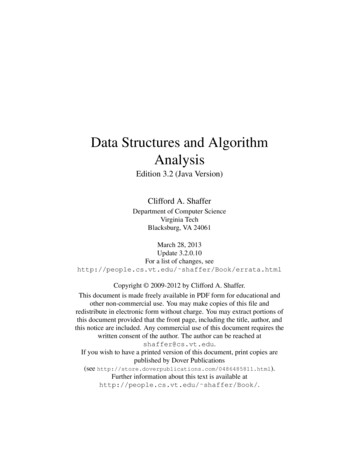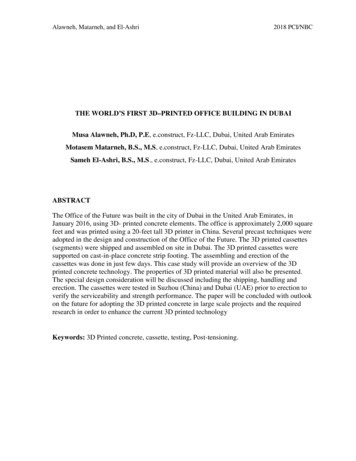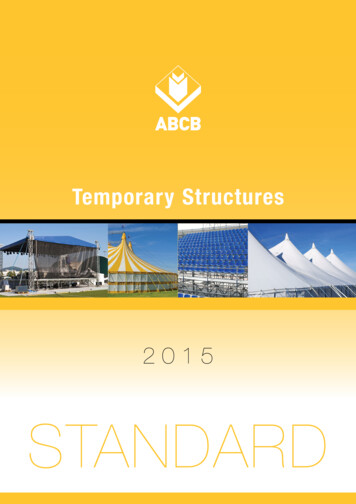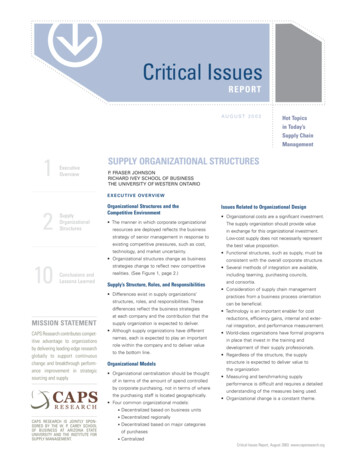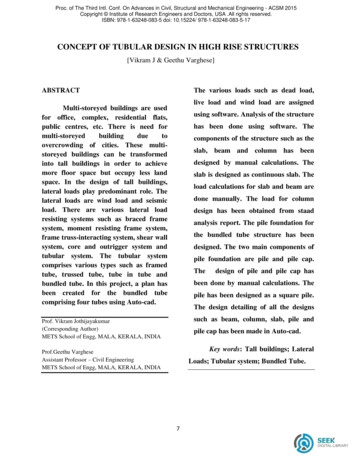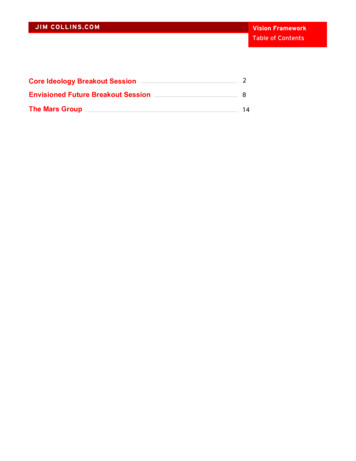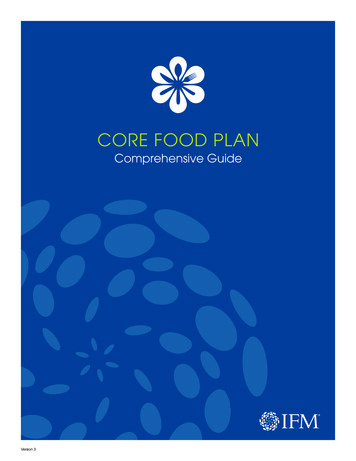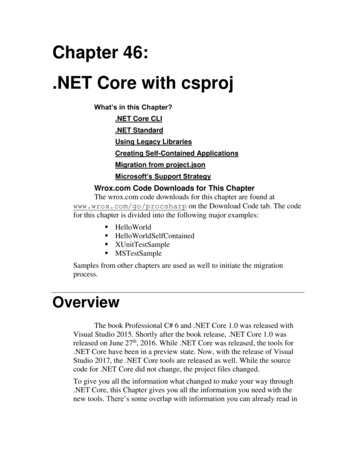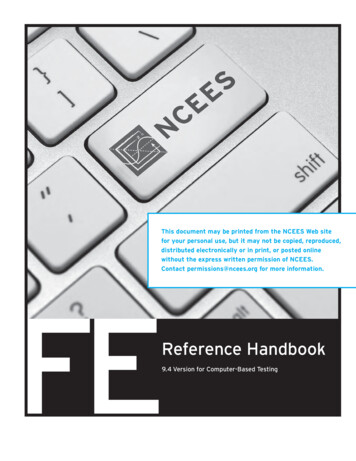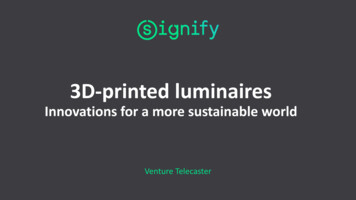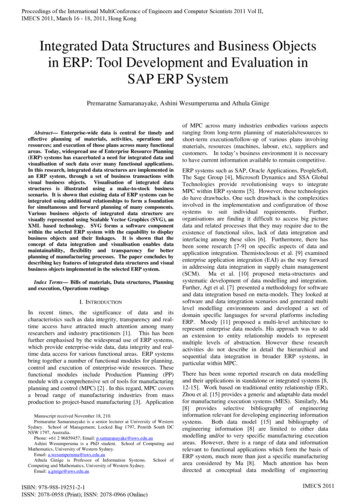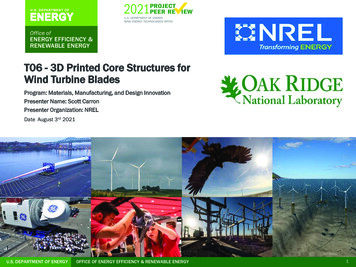
Transcription
T06 - 3D Printed Core Structures forWind Turbine BladesProgram: Materials, Manufacturing, and Design InnovationPresenter Name: Scott CarronPresenter Organization: NRELDate August 3rd 2021U.S. DEPARTMENT OF ENERGYOFFICE OF ENERGY EFFICIENCY & RENEWABLE ENERGY1
FY21 Peer Review - Project OverviewProject Summary: The challenge is to develop longer, lighter, and lower cost wind turbine blades for the windindustry to reduce the Levelized Cost of Energy (LCOE) and increase deployment.The project addresses this challenge using the state-of-the-art in advanced manufacturingtechnologies.The project focuses on utilizing 3D printing technologies and topology optimization todevelop large-scale 3D printed blade core structures for a 13m blade.The project will leverage cutting edge research and emerging technologies to develop 3Dprinted blade cores with the performance of aerospace honeycomb and the cost of balsa.The project is comprised of a world-class team of scientists and researchers at NREL withexpertise in blade design, and ORNL with expertise in large-scale additive manufacturing.Project Objective(s) 2019-2020: Develop the technical foundation to ensure technically robust 3D printed core solutionsare developed throughout the conceptual, preliminary, and detailed design phases of theproject.Document the technical foundation as a set of Technical Specifications and Requirementsconsisting of manufacturing design guidelines, material testing and characterizationprocesses, material design properties, design load cases, and structural requirements.Conduct a project review to ensure the project has the tools, data, methodology, andprocesses in place to begin the conceptual design phase.Project Start Year: [2020]Expected Completion Year: FY [2023]Total expected duration: [4] yearsFY19 - FY20 Budget: 792,013 (TOTAL) 434,013 (NREL) 358,000 (ORNL)Key Project Personnel:Scott Carron (NREL)Brian Post (ORNL)Key DOE Personnel:Benjamin Murray, Mike DerbyOverall Project Objectives (life of project): Develop a robust set of technical requirements to ensure the structural integrity of bladecore designs.Advance novel 3D printed blade core structural designs through rigorous conceptual,preliminary, and detailed design phases.Validate the final 3D printed core design through a full-scale build and test program.Deliver an extremely lightweight 3D printed blade core structure that outperformstraditional core structures such as balsa and foam on a strength, stiffness, mass, cost anddurability basis.U.S. DEPARTMENT OF ENERGYOFFICE OF ENERGY EFFICIENCY & RENEWABLE ENERGY2
Project Impact Benefits to the wind industry. Domestic manufacturing Domestically sourced materials Reduced transportation costs Increased opportunities for recyclability Higher performance blade structures Research needed. Aerospace is driving high cost, small-scale, long cycle time, high strength. Tooling is driving low cost, large-scale, long cycle time, low strength. Wind blades require low cost, large-scale, short cycle time, high strength. Project impact. 3D printing material property data 3D printing design methods Topology optimized blade structures Next generation blade designs Advanced structural design and validation methodsU.S. DEPARTMENT OF ENERGYOFFICE OF ENERGY EFFICIENCY & RENEWABLE ENERGY3
Program Performance – Scope, Schedule, ExecutionPhase2Phase 1 Phase3Phase4Phase5Phase6Phase 1 - Technical Specifications and Requirements Development (FY2020) Additive Manufacturing Guidelines Additive Manufacturing Materials Database Additive Material Testing and Characterization Additive Material Design Properties Design Load Cases Structural Requirements Project Review and Go/No-Go Decision Gate Phase 2 - Conceptual Design (FY2021) Phase 3 - Preliminary Design (FY2021/FY2022) Phase 4 - Detailed Design (FY2022/FY2023) Phase 5 – Blade Manufacture (FY2023) Phase 6 – Blade Validation (FY2023)U.S. DEPARTMENT OF ENERGYOFFICE OF ENERGY EFFICIENCY & RENEWABLE ENERGY4
Additive Manufacturing Design GuidelinesSandwich core sections of 13m DOE National Rotor Testbed (NRT) wind turbine blade (red) Additive manufacturing technology assessmentcriteria for 3D printed blade core Strength-to-weight Stiffness-to-weight Cost Cycle time Build volume Core cell sizeVATPowder Bed FusionPhotopolymerization Recyclability CompatibilityMaterial JettingSheet LaminationBinder JettingMaterial ExtrusionDirected EnergyDeposition7 Families of Additive Manufacturing Technologies (ASTM F2792)U.S. DEPARTMENT OF ENERGYOFFICE OF ENERGY EFFICIENCY & RENEWABLE ENERGY5
Additive Manufacturing Materials DatabaseMaterial Characterization Shear strength Shear modulus Tensile strength Tensile modulus Compressive strength Compressive modulus DensityMaterial Testing ASTM C273 – shear properties ASTM C393 – shear properties ASTM C297 – tensile properties ASTM C365 – compressive Properties ASTM C271 – densityASTM C273 test dataU.S. DEPARTMENT OF ENERGYOFFICE OF ENERGY EFFICIENCY & RENEWABLE ENERGY3D printed couponsASTM C273 test set-up.6
Structural Requirements Core Design Options BalsaCellular FoamHoneycombCorrugatedLatticeStiffened Panel Core Failure Criteria Face sheet failureCore shear failureGeneral bucklingFace wrinklingShear crimpingFace dimpling Blade Surface 13m DOE NRT blade3D printed 13m blade mold Core Design TargetsNote: Targets based on 150 kg/m3 end grain balsa material properties and 2020 costs.U.S. DEPARTMENT OF ENERGYOFFICE OF ENERGY EFFICIENCY & RENEWABLE ENERGY7
Design Loads and Structural Optimization Design Load Cases Edgewise - Ultimate Limit State (ULS) Flapwise - Ultimate Limit State (ULS) Maximum Resultant - Ultimate Limit State (ULS) Maximum Tip DeflectionSandwich core optimization process using finite element analysisU.S. DEPARTMENT OF ENERGYOFFICE OF ENERGY EFFICIENCY & RENEWABLE ENERGY8
Project Performance - Upcoming ActivitiesFY2021: Complete Technical Specifications and Requirements (partially delayed due to COVID-19 impact)Project Review (delayed due to COVID-19 impact)Begin Conceptual Design Phase Conceptual design (two-dimensional core geometries) Material testing and characterization (conceptual design support) Additive manufacturing (3D printing of core designs)FY2022 - FY2023: Conceptual Design ReviewPreliminary Design Phase Conceptual design (three-dimensional core geometries) Material testing and characterization (conceptual design support) Additive manufacturing (3D printing of core designs)Detailed Design Phase Final down select and detailed structural analysis Validate final design through testing and characterizationBlade Manufacturing Phase Blade Validation Phase 3D print final core designManufacture full-scale 13m demonstrator blade Perform full-scale static testingU.S. DEPARTMENT OF ENERGYOFFICE OF ENERGY EFFICIENCY & RENEWABLE ENERGY9
Stakeholder Engagement & Information Sharing Engagement Strategy The project is currently at a Technology Readiness Level (TRL) of 2 and intends to increase industryengagement as the TRL advances from early-stage to mid-stage (TRL 4-5). Industry engagement will include the additive manufacturing machine tool industry and wind turbine blademanufacturing industry. The engagement strategy will leverage the 205 industry and 54 university partners associated with ORNL’sManufacturing Demonstration Facility (MDF), and NREL’s partnerships and relationships with all majorwind manufacturers.Commercialization Pathway Commercialization pathways will be pursued as the TRL advances from early-stage to mid-stage.Communications and Outreach Strategy Wind Energy and Additive Manufacturing Industry Conferences (e.g., JEC World, AWEA Wind Power, SandiaBlade Workshop, Torque, IMTS, Rapid TCT) Industry Magazine Publications (e.g., Composites World, Additive Manufacturing) Social media channels (e.g., LinkedIn, DOE WETO news) Journal Publications (e.g., AIAA, Additive Manufacturing) NREL and ORNL technical publicationsU.S. DEPARTMENT OF ENERGYOFFICE OF ENERGY EFFICIENCY & RENEWABLE ENERGY10
develop large -scale 3D printed blade core structures for a 13m blade. The project will leverage cutting edge research and emerging technologies to develop 3D printed blade cores with the performance of aerospace honeycomb and the cost of balsa. The project is comprised of a wo
